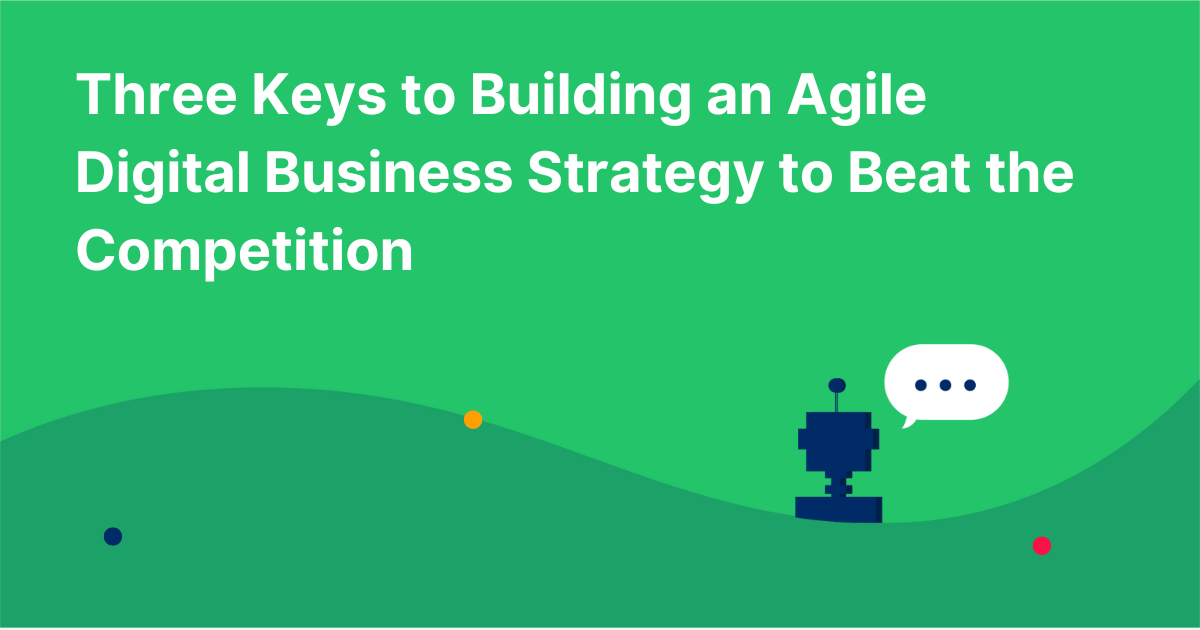In this era of constant evolution and fierce competition, it’s no secret that staying ahead requires more than just a traditional playbook. The digital realm beckons, offering unparalleled opportunities for growth and success. And guess what? A study from the brilliant minds at Gartner revealed that a whopping 56% of CEOs credit digital improvements for boosting their company’s revenues. Now, that’s a stat that’ll make any business enthusiast sit up and take notice!
So, if you’re ready to unlock the secrets of building an agile digital business strategy that leaves your competitors eating your digital dust, you’ve come to the right place. In this article, we’re going to delve into the three key elements that will empower you to chart a course toward triumph in the digital arena.

Automate Your Work
Capacity’s enterprise AI chatbot can help:
- Answer FAQs anytime, anywhere
- Find relevant documents within seconds
- Give surveys and collect feedback
If you don’t have one already, your business needs a well-thought-out plan to establish a solid online presence, engage with your target audience, and drive growth. A digital business strategy encompasses various elements, including website development, search engine optimization (SEO), social media marketing, content creation, and data analytics. By strategically integrating these components, companies can create a cohesive and effective digital ecosystem that enhances brand visibility, customer engagement, and overall business performance.
Now that the hard part’s over (phew!), let’s understand the essence of agility for digital business strategy before getting into the three keys. Agility refers to your organization’s ability to adapt quickly and efficiently to market changes, customer demands, and emerging technologies. It involves the integration of flexibility, speed, and innovation into all aspects of the business.
To stay competitive, businesses must be agile and capable of adjusting their strategies in real time. Agility allows companies to seize opportunities, mitigate risks, and stay ahead of the curve. By embracing an agile mindset, businesses can rapidly experiment with new digital initiatives, gather feedback, and make data-driven decisions. This iterative approach ensures the digital strategy remains relevant and practical and fosters continuous improvement and innovation.
Key 1: Have a customer-centric approach
A customer-centric approach lies at the heart of a successful digital business strategy. By understanding your customers’ needs, preferences, and pain points, you can tailor your offerings to provide exceptional value and experiences. Adobe found that experience-led companies have 1.6x higher customer satisfaction rates and 1.9x higher average order value. Here are three things to consider:
Understand your customers
Gain deep insights into your target audience by collecting data analytics, market research, and customer feedback. Identify their preferences, buying behavior, and challenges to comprehensively understand their needs. Use tools and technologies to capture and analyze customer data, such as social listening, surveys, and customer journey mapping.
Personalize your customer experience
Implement personalized marketing strategies and personalized product recommendations to create a tailored experience for your customers. Use data to deliver targeted content, offers, and recommendations based on their preferences, increasing customer satisfaction and loyalty. Employ customer segmentation and advanced personalization techniques to provide relevant and engaging experiences across various touchpoints.
Iterate, reiterate, and improve
Continuously iterate and refine your customer-centric initiatives based on feedback and market trends. Embrace an agile mindset that encourages experimentation and learning. Adopt an iterative approach to product development, marketing campaigns, and customer experience enhancements. Adapt your strategies based on real-time data to enhance the customer experience and drive business growth. Regularly measure and analyze key performance indicators (KPIs) to track progress and identify areas for improvement.
Key 2: Create agile operations
Building agile operations is essential to effectively support and execute your digital business strategy. Here are three key elements to consider:
Foster cross-functional collaboration
Break down silos and encourage collaboration across departments. Create a culture that values open communication, knowledge sharing, and teamwork. Cross-functional collaboration enables faster decision-making, smoother processes, and innovative problem-solving. Establish regular cross-departmental meetings, encourage collaborative tools and platforms, and promote a culture of shared goals and responsibilities.
Implement agile project management methods.
Embrace agile project management methodologies, such as Scrum or Kanban, to enhance efficiency and flexibility in project execution. These methodologies promote incremental delivery, regular feedback loops, and adaptation to changing requirements, enabling faster time-to-market and improved project outcomes. Empower project teams with the tools and resources to effectively manage projects using agile methodologies.
Embrace digital transformation
Emphasize the integration of digital technologies throughout your operations. Automate manual processes, adopt cloud-based solutions and use data analytics to streamline operations, enhance productivity, and gain actionable insights. Embracing digital transformation enables organizations to remain competitive in a rapidly evolving digital landscape. Invest in modern technologies such as artificial intelligence (AI), machine learning (ML), and robotic process automation (RPA) to optimize operations and improve decision-making processes.
Key 3: Innovate constantly
Innovation is the driving force behind sustained success in a digital business strategy. To foster innovation, consider the following:
Cultivate a culture of innovation
Encourage and empower employees to think creatively, challenge the status quo, and share their ideas. Foster an environment that rewards innovation and risk-taking. Implement innovation programs and initiatives that stimulate idea generation and experimentation. Establish channels for employees to contribute ideas, provide feedback, and collaborate on innovation projects. Recognize and celebrate innovative achievements within the organization.
Foster strategic partnerships
Collaborate with external partners, startups, or industry experts to learn from their expertise, technologies, or resources. Strategic partnerships can provide access to new markets, innovative solutions, and complementary capabilities, boosting your competitive advantage. Seek partnerships that align with your strategic objectives and bring unique value to your organization. Establish clear goals, expectations, and governance structures to ensure effective collaboration.
Don’t shy away from emerging technology
Keep a pulse on emerging technologies and trends that could disrupt your industry. Strategically embrace technological advancements such as artificial intelligence, blockchain, or the Internet of Things (IoT). Evaluate how these technologies can improve your operations, enhance customer experiences, and create new business opportunities. Stay informed about industry trends, attend relevant conferences and events, and engage with technology experts to stay ahead.
As you can see, building an agile digital business strategy is crucial for organizations to thrive in today’s competitive landscape. By adopting a customer-centric approach, creating agile operations, and fostering a culture of constant innovation, operations executives can position their companies ahead of the competition. Embrace the transformative power of digital technologies and stay committed to adapting and evolving to meet the ever-changing market demands. Remember, agility, innovation, and customer-centricity are the keys to unlocking success in the digital realm. You can build a solid foundation for long-term growth and sustainable competitive advantage with the right strategy.

Automate Your Work
Capacity’s enterprise AI chatbot can help:
- Answer FAQs anytime, anywhere
- Find relevant documents within seconds
- Give surveys and collect feedback














































